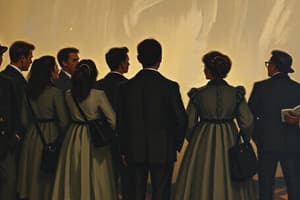Podcast
Questions and Answers
According to the passage, what is the primary factor that determines who becomes the de facto leader in different cities within the Tea Party Movement?
According to the passage, what is the primary factor that determines who becomes the de facto leader in different cities within the Tea Party Movement?
- Geography
- Social dynamics
- Economic circumstances
- All of the above (correct)
Which of the following best defines a group according to the passage?
Which of the following best defines a group according to the passage?
- A gathering of people who work together or share a hobby
- A lecture hall with 250 students
- A club or a regular gathering of friends
- Any collection of at least two people who interact with some frequency and share a sense of identity with the group (correct)
The passage suggests that the term 'group' is ___ in everyday conversation.
The passage suggests that the term 'group' is ___ in everyday conversation.
- Ambiguous (correct)
- Clearly defined
- Rarely used
- Interchangeable with 'crowd'
Which of the following is an example of a group mentioned in the passage?
Which of the following is an example of a group mentioned in the passage?
According to the passage, which of the following is NOT a characteristic of a group?
According to the passage, which of the following is NOT a characteristic of a group?
What is the primary purpose of the passage's discussion of groups?
What is the primary purpose of the passage's discussion of groups?
Which of the following is a key characteristic of a group according to the passage?
Which of the following is a key characteristic of a group according to the passage?
What is the primary difference between a group and a crowd according to the passage?
What is the primary difference between a group and a crowd according to the passage?
Which of the following is an example of a group mentioned in the passage?
Which of the following is an example of a group mentioned in the passage?
According to the passage, what is the key factor that distinguishes a group from a mere gathering of people?
According to the passage, what is the key factor that distinguishes a group from a mere gathering of people?
Study Notes
Group Dynamics
- Students often categorize themselves into in-groups and out-groups, which can define not only their friends but also their enemies.
- This categorization can lead to a sense of belonging, but also potential conflicts.
Group Size and Structure
- Larger groups often require formal leadership, while smaller groups tend to have informal leadership.
- In small, primary groups, leadership is often emergent and informal, whereas in secondary groups, leadership is more structured and formal.
- Examples of secondary groups with formal leadership include the military, workplaces, and classrooms.
Types of Groups
- The term "group" can be ambiguous, but in sociological contexts, it refers to a collection of at least two people who interact regularly and share a common identity.
- Groups can range in size from two people (e.g., a group project) to large gatherings (e.g., a club or a workplace).
- Not every gathering is a group; there must be some level of interaction and shared identity.
Group Leadership
- Instrumental leaders are goal-oriented and focused on achieving specific tasks.
- Small groups can struggle to achieve large goals and may be easier to ignore, but larger groups can garner more attention and pressure toward a common goal.
- As groups grow, the risk of division and lack of cohesion also increases.
Studying That Suits You
Use AI to generate personalized quizzes and flashcards to suit your learning preferences.
Description
Explore the concept of in-groups and out-groups, leadership structures in small and large groups, and the impact of group association on individuals. Learn about how group dynamics affect social interactions and decision-making.




